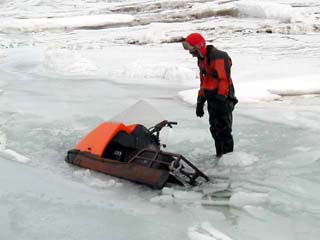Written by retired Lt. Bob Henke
During my first winter as a Conservation Officer, I found myself hurtling along the frozen surface of Lake George on a snowmobile, trying to keep up with my more seasoned partner who was in front of me on a larger,  more powerful sled. “Hurtling” is a relative term because in those days a snowmobile that would go 60MPH was a rocket, and the ones the state purchased were lucky to hit 35. However, it was before snowmobile suits, helmets, heated hand grips and suspensions so it was quite a ride, particularly in below zero weather.
more powerful sled. “Hurtling” is a relative term because in those days a snowmobile that would go 60MPH was a rocket, and the ones the state purchased were lucky to hit 35. However, it was before snowmobile suits, helmets, heated hand grips and suspensions so it was quite a ride, particularly in below zero weather.
The other officer was Tom Callahan. He was riding a big orange Massy-Harris snowmobile and I was on a bottom-of-the-line ski-doo which did not even have a brake–you had to pay extra for that as well as for a windshield, which it also lacked. The radios were the old lunch-box portables that took 12 D-cell batteries and could be used to heat up hot dogs on the antenna, or set your jacket on fire if it was against you while transmitting. Speaking of setting your jacket on fire, the reason that I got assigned that machine was because Conservation Officer Ron Robert decided to buy his own to use–one that had a windshield–after he was roaring down Brant Lake on the Ski-doo, with his corn cob pipe clenched in his teeth. The wind coming over the top of cowling acted much like a forge in that pipe, causing it to burn right through the bottom, sending a spray of sparks onto Ron’s jacket and setting him quite on fire. He wound up in his red long johns trying to load the sled back on the trailer and get home for more clothes.
To get back to the point of the story, as we crossed a small bay, I was horrified as the ice began to shatter behind my partner’s sled. Ten feet behind him, and following along for about 30 yards, the ice exploded, going from solid trail to platter-sized ice floes floating over 40 feet of real cold water. Stopping was not an option because, at that time, brakes were too, so my only choice was to give it full throttle and try to skip over it. Unbelievably, this worked and I plummeted up onto the shore, into about three feet of fluffy snow, where I sat gibbering and thanking my genes for a strong bladder.
My partner did not miss me for a couple miles. When he finally called on the radio, I told him what happened and a half hour later he arrived, coming along the shore, not on the ice. It was then I learned the proper procedure when your sled got wet was to turn it on its side and race the engine, spinning the track to dry it. Otherwise the bogey wheels froze solid – which they had. So after three hours by a roaring fire, the sled was operable, I was thoroughly lectured and we were back to the cars well before midnight, having bushwhacked along the shore the whole way. For some reason, my partner contended it was entirely my fault for not “reading the ice.”
I recall my grandfather waxing eloquent about “reading the ice.” There is folk wisdom about ice safety. Gramp said, “two inches will hold a man, four inches will hold a team, and 5 inches will hold a wagon.” Then he qualified it with elaborate explanations about blue ice, black ice, fluff ice, honeycomb ice, new ice, old ice, slob ice and a few other descriptors calculated to boggle a 10-year old. It worked.
Later, in college, it became clear when I learned how water freezes. Ever notice how lakes seem to freeze over suddenly? One night there is open water and the next morning it is solid ice. It works like this. The surface water is cooled by the cold air. This makes it denser than the water underneath and the cold water sinks. The downward movement of cold water takes place all around the edges of the lake and forces warmer water up in the center of the lake where it in turn is cooled. This starts a circular movement, up in the center, down around the edges, which continues until the entire mass of water is cooled to about 45 degrees. Now there is not enough temperature difference to move the water before the surface freezes. At this point ice forms across the entire surface of the lake and people start wanting to walk on it.
The first keys to evaluating ice safety are visual. When water first freezes, “new” or “black” ice is clear and brittle. It rests directly on top of a very dense, cold layer of water. Since it is transparent, you see the water beneath and the ice appears dark. Black ice may get up to two inches thick, but is very treacherous! Its brittleness makes it sensitive to vibration so the rhythm of walking or, as I learned so well, a motor can cause an area up to several hundred square feet to suddenly shatter into palm-sized pieces. It is a crystal, like glass, so ice itself is not strong. It supports weight because it floats. Like a boat, it can hold only so much weight. If it snows on black ice, the weight forces the ice downward, opening cracks, and allowing water to seep to the surface where the snow soaks it up like a giant sponge. This freezes on top of the black ice and is milky white. White or “fluff” ice is filled with air bubbles and is dangerous. It is like walking on a floating block of Styrofoam. It supports a lot unless there is a crack, whereupon it flips up, dumps you in, and closes back over the top.
Snow cover or a layer of white ice insulates, and slows the freezing process, but clear cold nights will finally “make ice,” freezing from the bottom in successive interconnected layers. The best ice is that which builds up these interlocking layers of crystals. You may have noticed this as both vertical and horizontal lines in sides of ice fishing holes. The strong interlaced structure makes it opaque and gives the ice a blue or flat grey color. Four inches of “blue ice” is usually considered safe for most winter activities—but I like a foot or more. Blue ice also reflects most of the indirect winter sun, accounting for that sunburned face after a day of ice fishing.
In the spring, increasingly direct rays of the sun shining through the ice, warms the underlying layer of water and restarts the circular movement in reverse. This movement, coupled with warm water from spring run-off, melts certain areas faster than others. In a smooth bottomed lake, melting takes place first in the center. Now we can have a very inconsistent cover known as “honeycomb” ice. The pockets of much thinner ice look dark, giving the surface a spotted appearance. This is the ice that holds you just fine in one place and drops you through a few feet away.
Falling through the ice is never fun. I wound up with only psychological scars; you may not be so lucky. The fact that someone went ahead of you is no assurance that you can also proceed safely, especially during a winter with fluctuating temperatures. Read the ice yourself, carry some spikes to get out if the worst happens and be careful.

